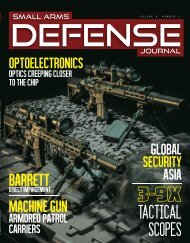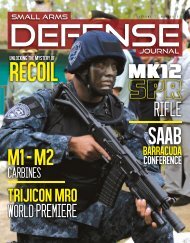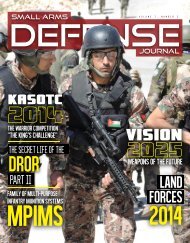SAR 18#6
Create successful ePaper yourself
Turn your PDF publications into a flip-book with our unique Google optimized e-Paper software.
self-loading rifle for the Polish Army. The<br />
requirements were: weapon chambered<br />
in the service caliber (7.9mm Mauser),<br />
not heavier than 4.5 kg, with a magazine<br />
capacity of 10 rounds, barrel length<br />
equal to the service wz.29 carbine (600<br />
mm), easy to operate, simple in design,<br />
reasonable number of parts and manufactured<br />
with simple production methods.<br />
The deadline was 31 December,<br />
1934. Nine rifles were proposed, but unfortunately<br />
most are only known by the<br />
codenames: 14895, ABC-34, BK, Celer,<br />
ES, Gajos, Samopał, SKS and Turniej.<br />
The jury, under ITU commander<br />
Lt. Col. Czesław Kunart, selected on 8<br />
January, 1935 three rifles for further development:<br />
SKS by Engineer Stefański<br />
(unfortunately the given name is absent<br />
from all correspondence), ES by Edward<br />
Szteke and Turniej by Józef Maroszek.<br />
The Stefański SKS rifle was a<br />
gas-operated weapon with the gas cylinder<br />
on top of the barrel. During development<br />
the original SKS got ‘thoroughly<br />
redesigned’ into kb.sp. wz.34 but the<br />
details are missing. In 1938 due to no<br />
progress evident in subsequent testing<br />
it was discontinued.<br />
Edward Szteke’s ES rifle was a lever-retarded<br />
blowback recoil-operated<br />
weapon, with fixed barrel; somewhat<br />
along the lines of the HK G3, but with<br />
kidney-shaped levers instead of rollers.<br />
It was patented in Poland, Europe and<br />
the U.S. in 1933-1937. Mr. Chinn may<br />
be right on many things in his monumental<br />
series of books The Machine<br />
Gun, but how he managed to find in it<br />
a predecessor of the MG 42 is a mystery.<br />
Perhaps he mistook MG 42 (short<br />
recoil gun, roller locked with recoiling<br />
barrel) with MG 42V, Vereinfacht, or<br />
Simplified, prepared to be introduced<br />
into the Wehrmacht’s inventory as the<br />
MG 45 – a retarded blowback with fixed<br />
barrel, like the ES...<br />
Maroszek Rifle<br />
The Maroszek ‘Turniej’ was a<br />
gas-operated weapon, but the details of<br />
his original design, especially the lock,<br />
we cannot ascertain for lack of documents.<br />
Polish ordnance archives were<br />
pretty thoroughly sieved, vetted and dispersed,<br />
first by the capturing Germans<br />
and Soviets in 1939, then by Germans<br />
re-capturing them from the Soviets, and<br />
then in 1945 by the British, American,<br />
French and Soviets, capturing them<br />
once again from the Germans.<br />
Szteke’s rifle was judged<br />
the best while Maroszek placed third.<br />
Regardless, he was too busy designing<br />
his AT rifle, which was given<br />
much higher priority, and so he was<br />
given a respite, while ES and SKS<br />
were toiled upon.<br />
In 1936 the rifles were progressing<br />
steadily, but as the AT rifle was then<br />
ready for production, the SLR board<br />
requested Maroszek to submit a prototype.<br />
Meanwhile, he had an epiphany<br />
as to the locking system of his rifle,<br />
and instead of starting to build his original<br />
rifle, he turned it inside out to accommodate<br />
his new idea of tilt-locking<br />
the bolt into the ejection opening of the<br />
receiver – what we now call a Browning-Petter<br />
locking, generally associated<br />
with handguns. The new receiver was<br />
much shorter, with no need for barrel<br />
extension. The return spring is similar to<br />
the BAR – but the original M1918, not<br />
the wz.28 Polish one – being stored inside<br />
the bolt-carrier and gas piston. The<br />
new ideas seemed plausible enough<br />
to grant him six weeks deadline extension<br />
in which to redesign the rifle from<br />
scratch. In mid-1936 at the No.2 Armory<br />
at 2/4 Szwedzka Str. in Warsaw’s Praga<br />
district, a three-man team which last<br />
year cooperated with Maroszek in preparing<br />
the AT Rifle production set to<br />
manufacturing parts for his second<br />
<strong>SAR</strong> Vol. 18, No. 6 78 Nov., Dec. 2014









